人教版英语必修四unit 4(reading:munication:no problem)教案
- 格式:docx
- 大小:21.86 KB
- 文档页数:4

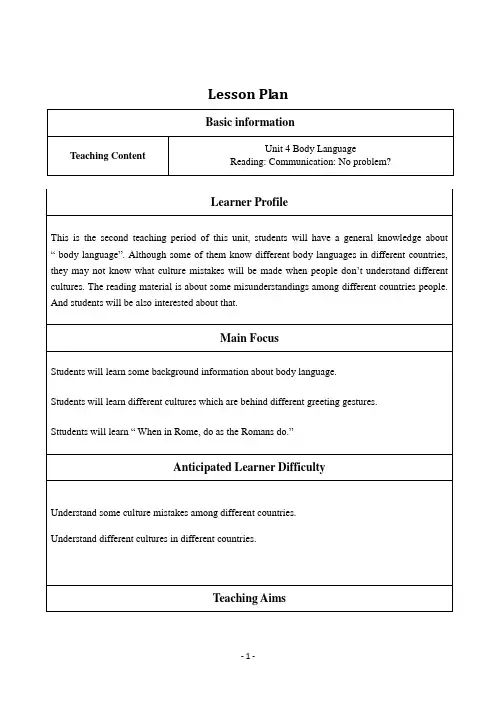
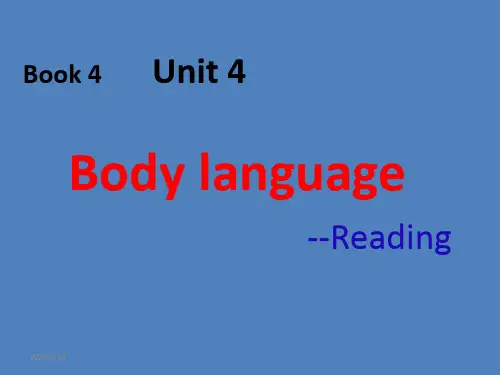
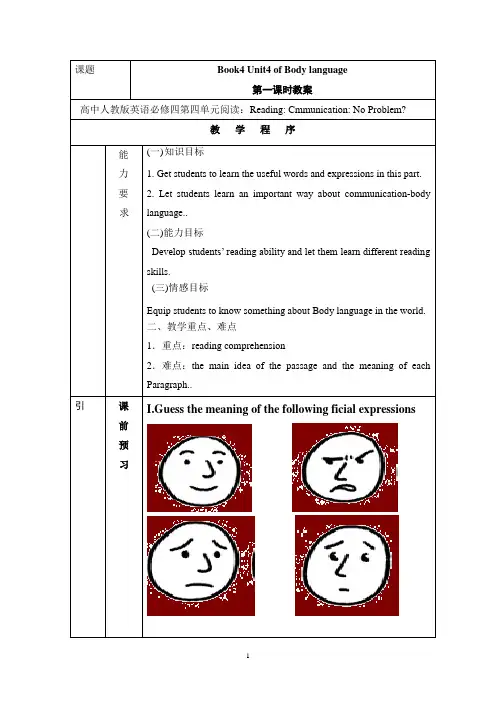
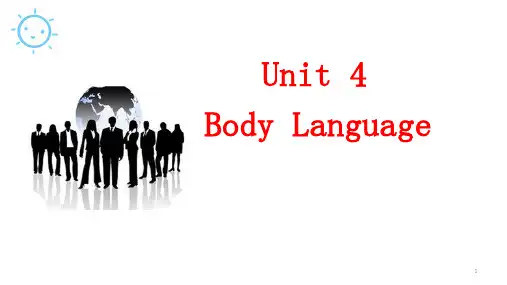

Book4 Unit 4 Body LanguageCommunication: No Problem?一、教材分析本单元的中心话题是“肢体语言”,介绍了肢体语言在世界范围内的人们生活中所承担的不同角色及重要作用,还介绍了世界通用的肢体语言。
Reading部分通过举例说明不同地区表达问候的肢体语言的不同,总结出不同文化背景下肢体语言的不同含义。
肢体语言这一话题贴近生活,学生学习本单元较有兴趣。
课前要求学生标注部分生词并预习课文。
二、学情分析我所教是普通班,学生的英语基础差距较大,但总体英语水平还是比较薄弱。
所以我在设置的问题尽可能的简单,使他们有信心完成阅读任务。
三、学习目标1.知识目标1) let students know more about the cultural differences of using body language.2) let students know some new words and expressions2.能力目标develop students’reading skills(skimming and scanning)as well as speaking ability.3.情感目标Increase students’ awareness of using body language correctly in different cultures.四、教学重点let students master the differences and similarity of body language in different parts of the world.五、教学难点1. develop students’ reading ability2. ask the students to show their opinions in English.六、教学方法1. task-based teaching and learning2. discussion七、教学过程Step 1warming up1.首先由“waysofcommunicating”引出“bodylanguage”,包括facialexpression,gesture,action.接着通过一些图片来表现不同的肢体语言。


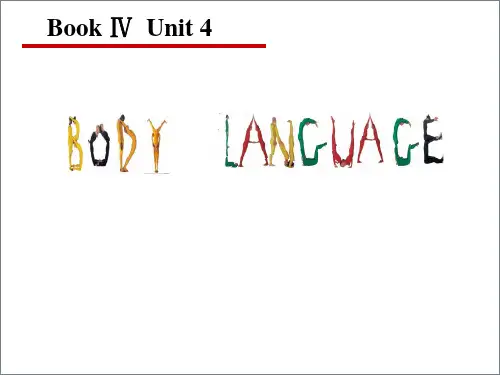
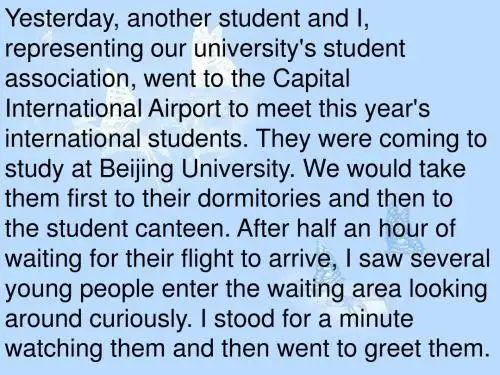
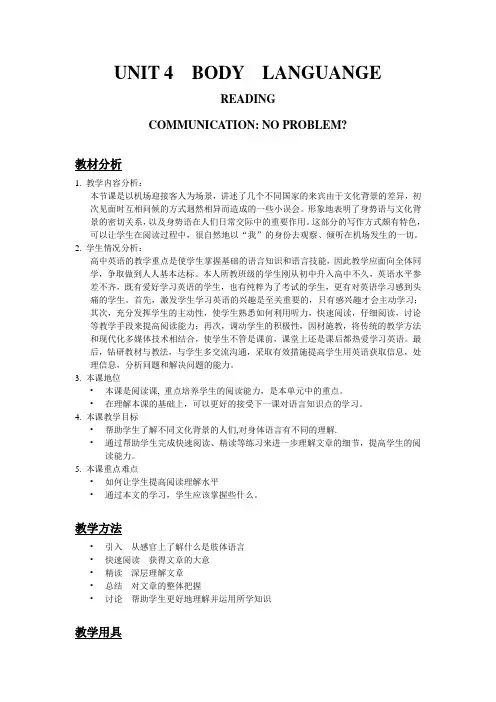
UNIT 4 BODY LANGUANGEREADINGCOMMUNICATION: NO PROBLEM?教材分析1. 教学内容分析:本节课是以机场迎接客人为场景,讲述了几个不同国家的来宾由于文化背景的差异,初次见面时互相问候的方式迥然相异而造成的一些小误会。
形象地表明了身势语与文化背景的密切关系,以及身势语在人们日常交际中的重要作用。
这部分的写作方式颇有特色,可以让学生在阅读过程中,很自然地以“我”的身份去观察、倾听在机场发生的一切。
2. 学生情况分析:高中英语的教学重点是使学生掌握基础的语言知识和语言技能,因此教学应面向全体同学,争取做到人人基本达标。
本人所教班级的学生刚从初中升入高中不久,英语水平参差不齐,既有爱好学习英语的学生,也有纯粹为了考试的学生,更有对英语学习感到头痛的学生。
首先,激发学生学习英语的兴趣是至关重要的,只有感兴趣才会主动学习;其次,充分发挥学生的主动性,使学生熟悉如何利用听力,快速阅读,仔细阅读,讨论等教学手段来提高阅读能力;再次,调动学生的积极性,因材施教,将传统的教学方法和现代化多媒体技术相结合,使学生不管是课前,课堂上还是课后都热爱学习英语。
最后,钻研教材与教法,与学生多交流沟通,采取有效措施提高学生用英语获取信息,处理信息,分析问题和解决问题的能力。
3. 本课地位•本课是阅读课, 重点培养学生的阅读能力,是本单元中的重点。
•在理解本课的基础上,可以更好的接受下一课对语言知识点的学习。
4. 本课教学目标•帮助学生了解不同文化背景的人们,对身体语言有不同的理解.•通过帮助学生完成快速阅读、精读等练习来进一步理解文章的细节,提高学生的阅读能力。
5. 本课重点难点•如何让学生提高阅读理解水平•通过本文的学习,学生应该掌握些什么。
教学方法•引入---从感官上了解什么是肢体语言•快速阅读---获得文章的大意•精读---深层理解文章•总结---对文章的整体把握•讨论---帮助学生更好地理解并运用所学知识教学用具•录音机•多媒体教学程序Step I. 引入请同学们观看一些录像和图片了解肢体语言的种类。
Book4 Unit 4 Body Language
Communication: No Problem?
一、教材分析
本单元的中心话题是“肢体语言”,介绍了肢体语言在世界范围内的人们生活中所承担的例外角色及严重作用,还介绍了世界通用的肢体语言。
Reading部分通过举例说明例外地区表达问候的肢体语言的例外,总结出例外文化背景下肢体语言的例外含义。
肢体语言这一话题贴近生活,学生学习本单元较有兴趣。
课前要求学生标注部分生词并预习课文。
二、学情分析
我所教是普通班,学生的英语基础差距较大,但总体英语水平还是比较单薄。
所以我在设置的问题尽可能的简单,使他们有信心完成阅读任务。
三、学习目标
1.知识目标
1) let students know more about the cultural differences of using body language.
2) let students know some new words and expressions
2.能力目标
develop students’reading skills(skimming and scanning)as well as speaking ability.
3.情感目标
Increase students’ awareness of using body language correctly in different cultures.
四、教学重点
let students master the differences and similarity of body language in different parts of the world.
五、教学难点
1. develop students’ reading ability
2. ask the students to show their opinions in English.
六、教学方法
1. task-based teaching and learning
2. discussion
七、教学过程
Step 1warming up
1.首先由“waysofcommunicating”引出“bodylanguage”,包括facialexpression,gesture,action.接着通过一些图片来表现例外的肢体语言。
这个环节主要是为了引起学生的阅读兴趣。
2.让学生观察课本P25的四幅图片并表述其肢体语言所传达的含义。
Step 2pre-reading
1.通过提问“H ow many ways can you think of to greet someone if you cannot speak?”引出本篇文章的主题。
向学生展示一些图片,以便学生更清撤地了解例外地区表示问候的肢体语言。
2.Predicting.让学生借助文章的题目和图片,预测文章的主题和主要内容,对文章有初步的了解。
Step 3 Reading
1.Answer two questions.
How many international students are there in the story?
Who are they and where are they come from?
2.skimming
在这个环节中,要求学生快速阅读,找出文章和每段的大意,有助于学生更好地把握全文。
Readthepassageanddividethewholepassageintoseveralpartsandmatchthemain idea.
Part 1(Para. 1)People from different countries express greetings in different ways.Part 2(Para. 2-3)Meet the visitors at the airport.
Part 3(Para. 4)Summary of body language.
Part 4(Para. 5)Different peoples have different body languages.
Try to finish the main idea of the text.
The text is mainly about different ______________ in different countries. In order to avoiddifficulties in today’s world of cultural crossroads, we
should________________________.
3.scanning
Read the passage quickly and finish jinban P43 task2.
4.careful reading
How do different international students behave when they greet people? Completethe chart with information from the passage. P27
Name
Tony Garcia
NameDescription
man from Japan
DescriptionBody Language
no touching
Body LanguageToWhomeveryone
ToWhomto men
to womenGeorgeCook
shakehandsandkisstwice
on each cheek
Read the text carefully, and do the T or F. If false, correct the mistakes.
1. English men often stand close to others or touch strangers as soon as they meet.()
2. Most people around the world now greet each other by kissing. ()
3. Japanese will bow to others as greeting. ()
5.post reading
Answer the following questions.
Is the author of this passage male or female? How do you know?
“WheninRome,doastheRomansdo.”Whatdoyouthinkthisfamoussayingmeans?
Step 5 Homework
1.Finish the exercise
2.line out some difficult sentences and useful language points.
3.。